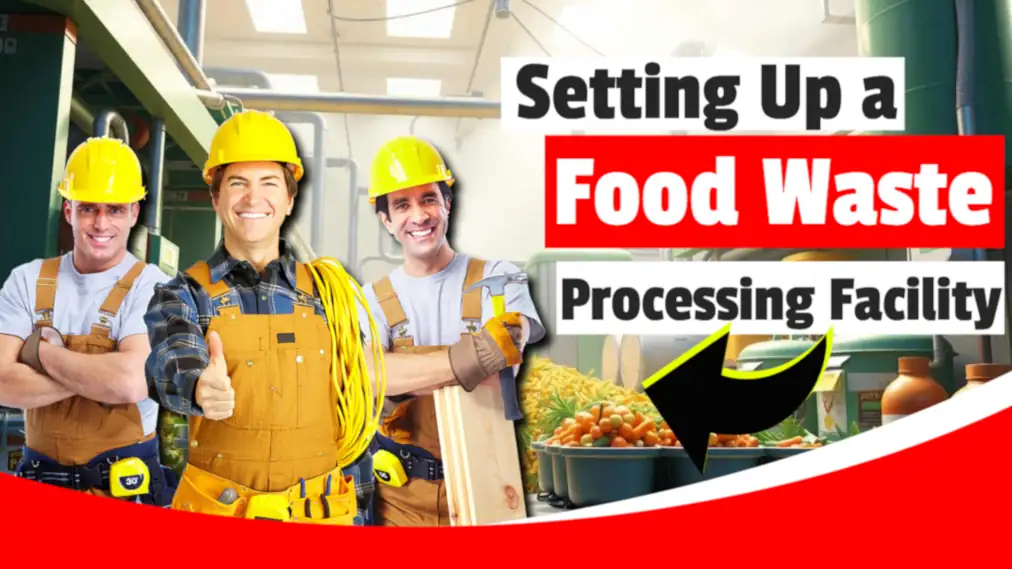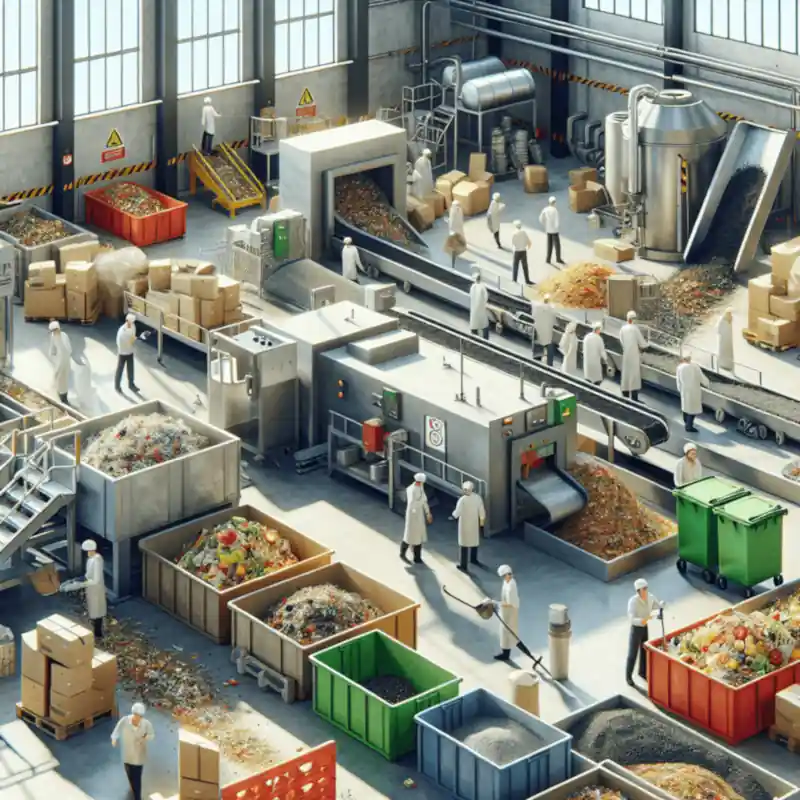In a world increasingly conscious of sustainability and environmental responsibility, setting up a food waste processing facility stands out as a pivotal step toward reducing ecological footprints and promoting circular economies. Whether you’re a municipality aiming to manage waste more effectively or a private enterprise seeking sustainable solutions, establishing a food waste processing facility involves a comprehensive process that ensures efficiency, compliance, and long-term operational success. This guide walks you through each critical phase, from initial planning and site selection to the nuances of operation and maintenance.
Planning Your Food Waste Processing Facility
Launching a food waste processing facility begins with meticulous planning. This foundational stage sets the tone for the project’s success, establishing clear objectives, budgets, and timelines.
Assessing Needs and Objectives
Begin by identifying the specific goals of your facility. Are you aiming to reduce landfill usage, generate renewable energy, or produce compost for agricultural use? Clarifying these objectives will guide subsequent decisions, ensuring that the facility aligns with your environmental and business aspirations.
Conducting a Feasibility Study
A feasibility study evaluates the practicality of your project, considering factors like local waste generation rates, available technology, and financial viability. This study should encompass:
- Market Analysis: Understanding the demand for processed food waste products.
- Financial Projections: Estimating initial investments, operating costs, and potential revenue streams.
- Risk Assessment: Identifying potential challenges and developing mitigation strategies.

Site Selection: Choosing the Right Location
Selecting an appropriate site is paramount to the facility’s operational efficiency and regulatory compliance. Several factors must be considered to ensure the location supports both current needs and future growth.
Proximity to Waste Sources
The facility should be strategically located near major food waste generators, such as restaurants, grocery stores, and food processing plants. Proximity minimizes transportation costs and reduces the carbon footprint associated with waste collection.
Accessibility and Infrastructure
Ensure the site is accessible via major transportation routes for easy movement of waste materials and finished products. Additionally, assess the availability of essential infrastructure, including:
- Utilities: Reliable access to electricity, water, and sewage systems.
- Transport Facilities: Adequate space for loading and unloading materials.
Regulatory Compliance and Zoning
Verify that the chosen location complies with local zoning laws and environmental regulations. Engaging with local authorities early in the process can facilitate smoother approvals and adherence to legal requirements.
Suggested Image: [Map highlighting optimal site locations based on proximity and infrastructure]
Designing the Facility: Blueprint for Success
A well-designed facility ensures smooth operations, optimizes space usage, and incorporates safety standards. Collaborate with experienced engineers and designers to develop a layout that aligns with your processing needs.
Process Flow Planning
Outline the sequence of operations, from waste intake to processing and output. This includes areas designated for:
- Waste Reception: Initial intake and sorting of food waste.
- Processing Units: Machinery and technology for transforming waste into usable products.
- Storage: Secure areas for both incoming waste and finished products.
- Administration: Offices and staff facilities.
Suggested Diagram: [Process flowchart illustrating each stage of the facility]
Incorporating Sustainable Practices
Integrate eco-friendly design elements, such as energy-efficient lighting, renewable energy sources, and water recycling systems. Sustainable design not only reduces operational costs but also enhances the facility’s environmental credentials.
Securing Permits and Approvals
Navigating the regulatory landscape is crucial to legally operate your food waste processing facility. This involves obtaining various permits and ensuring compliance with environmental and safety standards.
Environmental Impact Assessments (EIA)
Conduct an EIA to evaluate the potential environmental effects of your facility. This assessment should address:
- Air Quality: Emissions control measures.
- Water Usage: Sustainable water management practices.
- Waste Management: Handling and disposal of residuals.
Suggested Table: [Checklist of required permits and corresponding regulatory bodies]
Safety and Health Regulations
Adhere to occupational health and safety standards to protect employees and the surrounding community. Implement necessary safety protocols and ensure that all equipment meets industry safety certifications.
Selecting the Right Technology and Equipment
Choosing appropriate technology is critical to the efficiency and effectiveness of your food waste processing operations. Evaluate various options based on processing capacity, energy consumption, and scalability.
Processing Technologies
Different technologies serve distinct purposes. Some common options include:
- Anaerobic Digesters: Convert organic waste into biogas and digestate.
- Composting Systems: Transform food waste into nutrient-rich compost.
- Mechanical Shredders: Reduce waste size for easier handling and processing.
Equipment Sourcing and Installation
Partner with reputable suppliers to procure high-quality equipment. Ensure that installation adheres to manufacturer guidelines and industry best practices to prevent operational issues down the line.
Suggested Video: [Tutorial on selecting and installing food waste processing equipment]
Construction and Facility Setup
The construction phase brings your plans to life, transforming blueprints into a functional processing facility. This stage requires careful project management to stay on schedule and within budget.
Project Management
Appoint a project manager to oversee construction activities, coordinate with contractors, and ensure that the project adheres to timelines and specifications.
Quality Assurance
Implement quality control measures to guarantee that construction meets all design and regulatory standards. Regular inspections and testing can help identify and rectify issues promptly.
Suggested Image: [Construction progress photo of a food waste processing facility]
Operational Strategies for Efficiency
Once the facility is constructed, developing effective operational strategies is essential for maximizing productivity and minimizing costs.
Waste Collection and Intake
Establish reliable waste collection systems, including scheduled pickups and intake procedures. Efficient intake processes prevent bottlenecks and ensure a steady flow of material for processing.
Processing Optimization
Monitor processing parameters continuously to maintain optimal performance. Implement automation where possible to enhance precision and reduce manual intervention.
Workforce Training
Invest in comprehensive training programs for staff to ensure they are proficient in operating equipment, adhering to safety protocols, and managing daily tasks effectively.
Numbered List: Steps to optimize processing operations
- Monitor Processing Rates: Regularly track the speed and efficiency of processing units.
- Maintain Equipment: Schedule routine maintenance to prevent downtime.
- Implement Feedback Loops: Use data analytics to identify areas for improvement.
- Foster a Culture of Excellence: Encourage continuous learning and innovation among staff.
Maintenance Best Practices
Regular maintenance is vital to sustain the facility’s performance and longevity. Proactive maintenance schedules and swift response to issues can prevent costly downtime and extend equipment life.
Preventive Maintenance
Develop a maintenance schedule that includes routine inspections, cleaning, and part replacements. Preventive measures help identify potential problems before they escalate.
Emergency Response Plan
Prepare for unexpected equipment failures or operational disruptions by establishing an emergency response plan. This plan should outline immediate actions, responsible personnel, and communication protocols.

Ensuring Compliance and Sustainability
Maintaining compliance with environmental and safety regulations is an ongoing responsibility that safeguards your facility’s operations and reputation.
Environmental Sustainability
Adopt practices that minimize environmental impact, such as:
- Energy Conservation: Utilize energy-efficient technologies and renewable energy sources.
- Water Management: Implement systems for water recycling and reduce overall consumption.
- Waste Minimization: Strive for zero waste by repurposing all by-products.
Regulatory Compliance
Stay updated with evolving regulations and standards in waste management and environmental protection. Regular audits and assessments can help ensure continued compliance.
Suggested Table: [List of key sustainability practices and their benefits]
Overcoming Common Challenges
Setting up and operating a food waste processing facility comes with its set of challenges. Addressing these proactively can pave the way for smoother operations and long-term success.
Managing Variable Waste Streams
Food waste can vary in composition and volume, making standardization difficult. Implement flexible processing systems and robust sorting mechanisms to handle diversity effectively.
Securing Continuous Funding
Initial investments and ongoing operational costs can be substantial. Explore various funding options, including grants, loans, and partnerships, to ensure financial stability.
Navigating Regulatory Changes
Regulations can shift, impacting operational procedures and compliance requirements. Build a responsive management team adept at adapting to regulatory changes promptly.
Numbered List: Solutions to common challenges
- Diversify Funding Sources: Combine multiple financing methods to reduce dependency on a single source.
- Implement Advanced Sorting Technologies: Enhance flexibility in processing varied waste streams.
- Engage with Regulatory Experts: Stay informed about potential changes and prepare accordingly.
- Foster Community Relationships: Build strong ties with local stakeholders to garner support and collaboration.
Leveraging Technology for Future Growth
Incorporating advanced technologies can propel your facility toward increased efficiency and scalability, positioning you at the forefront of sustainable waste management.
Automation and Smart Systems
Integrate automation to streamline operations, reduce human error, and enhance processing speed. Smart monitoring systems can provide real-time data, facilitating informed decision-making.
Data Analytics
Utilize data analytics to track performance metrics, identify trends, and optimize processes. Data-driven insights can lead to improved operational strategies and resource management.
Expansion and Scalability
Design your facility with future growth in mind. Modular designs and scalable technologies allow for easy expansion as waste generation increases or processing demands evolve.
Suggested Video: [The role of automation in modern food waste processing facilities]
Partnering with Experts for Success
Embarking on the journey to set up a food waste processing facility can be complex. Partnering with industry experts ensures that you navigate each stage with confidence and precision.
Consulting Services
Engage with consultants who specialize in waste management and facility design. Their expertise can guide you through planning, regulatory compliance, and technology selection, ensuring that your facility is both efficient and compliant.
Ongoing Support and Training
Establish relationships with technology providers and service partners who offer ongoing support and training. Continuous learning opportunities for your team can lead to sustained operational excellence.
Ready to transform food waste into valuable resources? Contact us today!
to discuss how we can assist you in setting up a state-of-the-art food waste processing facility tailored to your needs.
Conclusion: A Sustainable Future Starts Here
Setting up a food waste processing facility is more than an operational decision; it’s a commitment to sustainability, innovation, and community well-being. By meticulously planning each phase, embracing advanced technologies, and prioritizing environmental compliance, you pave the way for a facility that not only manages waste effectively but also contributes to a greener, more sustainable future.
Call to Action: Take the first step toward impactful waste management solutions. Get in touch with our experts to begin your journey in establishing a cutting-edge food waste processing facility.

